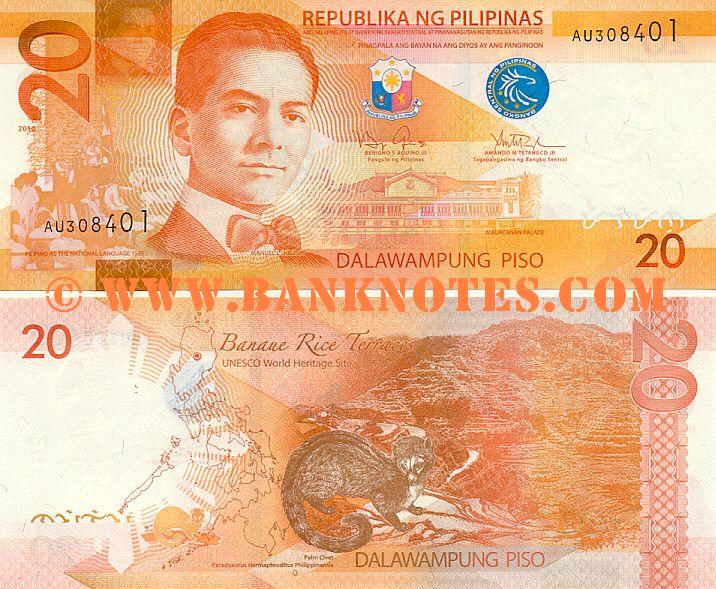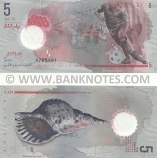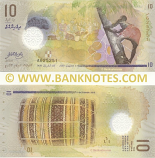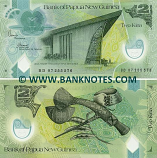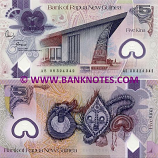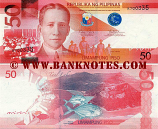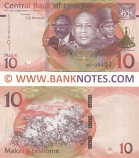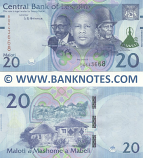20 Piso 2010 (Front: Effigy of the President Manuel Luis Quezon y Molina (19 August 1878 – 1 August 1944), president of the Commonwealth of the Philippines from 1935 to 1944. Filipino* (Pilipino, Tagalog) as the national language (1935): Wenceslao Vinzons, a young representative from Camarines Norte at the 1935 Constitutional Convention, officially proposing to include an article on developing a national language. Malacañan Palace (Malacañang, Malakanyang, Presidential Palace) as viewed from Pasig River. Coat of arms. Central bank logo. Back: Map outline of the Philippines. Banaue Rice Terraces (UNESCO World Heritage Site). Common Palm Civet (Paradoxurus Hermaphroditus Philippinensis). Indigenous weave design from the Cordillera Administrative Region. Watermark: Portrait of Manuel L. Quezon; Electrotype "20". Main colour: Orange. Signatures: Benigno Simeon Cojuangco Aquino III (Pangulo ng Pilipinas); Amando M. Tetangco, Jr. (Tagapangasiwa ng Bangko Sentral). Issuer: Central Bank of the Philippines. Date of Issue: 16 December 2010. Printer: Francois-Charles Oberthur Fiduciaire — Oberthur Technologies (FCOF))
Dimensions: 161 x 66 mm
Catalogue Number: P-206a (SCWPM: Pick; Krause)
Texts: Republika Ng Pilipinas. Bangko Sentral Ng Pilipinas. Dalawampung Piso. Twenty Piso. Ang Salaping Ito Ay Bayarin Ng Bangko Sentral At Pinananagutan Ng Republika Ng Pilipinas.Pinagpala Ang Bayan Na Ang Diyos Ay Ang Panginoon
Remark: Wenceslao Vinzons, a young representative from Camarines Norte in the 1935 Constitutional Convention, officially proposed to include an article on developing a national language. Thus, the 1935 Constitution Article XIV, Section 3, states that the Congress “shall make necessary steps towards the development of a national language which will be based on one of the existing native languages.”The following year, the National Assembly passed Commonwealth Act No. 184, establishing the Institute of National Language on November 13, 1936, that decided which among the existing native languages will be the basis for the national language. Jaime C. de Veyra from Leyte was the first director. Eminent linguists, representing different linguistic groups, were the other members of the institute. After studying the case, the institute recommended Tagalog to be the basis of the national language. In 1937, Executive Order No. 134 was passed stating that the national language will be based on Tagalog.
Dimensions: 161 x 66 mm
Catalogue Number: P-206a (SCWPM: Pick; Krause)
Texts: Republika Ng Pilipinas. Bangko Sentral Ng Pilipinas. Dalawampung Piso. Twenty Piso. Ang Salaping Ito Ay Bayarin Ng Bangko Sentral At Pinananagutan Ng Republika Ng Pilipinas.Pinagpala Ang Bayan Na Ang Diyos Ay Ang Panginoon
Remark: Wenceslao Vinzons, a young representative from Camarines Norte in the 1935 Constitutional Convention, officially proposed to include an article on developing a national language. Thus, the 1935 Constitution Article XIV, Section 3, states that the Congress “shall make necessary steps towards the development of a national language which will be based on one of the existing native languages.”The following year, the National Assembly passed Commonwealth Act No. 184, establishing the Institute of National Language on November 13, 1936, that decided which among the existing native languages will be the basis for the national language. Jaime C. de Veyra from Leyte was the first director. Eminent linguists, representing different linguistic groups, were the other members of the institute. After studying the case, the institute recommended Tagalog to be the basis of the national language. In 1937, Executive Order No. 134 was passed stating that the national language will be based on Tagalog.

